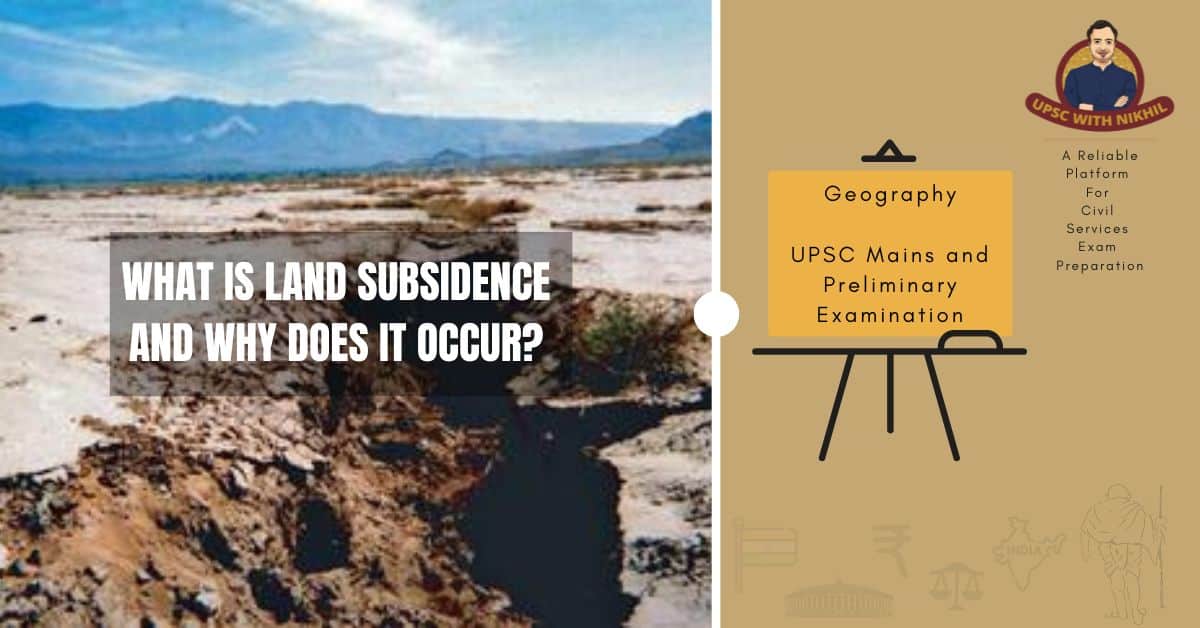What Is Land Subsidence And Why Does It Occur?
Recent Crisis:
Joshimath Crisis - Joshimath is perishing, although the precise origin of the Joshimath land subsidence is uncertain, scientists point to uncontrolled construction, population growth, water flow restriction, and hydropower activities as potential contributors. Authorities in Joshimath, Uttarakhand, declared it a landslide and subsidence-hit zone on Sunday, almost a week after fissures started to develop in numerous roads and hundreds of homes there.
The announcement followed a high-level meeting between senior Central government officials, representatives from the state of Uttarakhand, and senior officers from organizations such as the National Disaster Management Authority (NDMA), Geological Survey of India (GSI), and the National Institute of Hydrology (NIH). According to officials, 68 households have already been moved to temporary relief centers as of Sunday, and another 90 families will be evacuated shortly.
What Land Subsidence Is And How It Might Have Contributed To The Joshimath Catastrophe?
Subsidence, as defined by the National Oceanic and Atmospheric Administration (NOAA), is the term used to describe the earth sinking as a result of subterranean material movement. Numerous factors, both natural and man-made, including mining operations and the loss of water, oil, or other natural resources, can cause it. Subsidence has many well-known causes, including earthquakes, soil erosion, and soil compaction. Additionally, according to the website of the US-based organization, this phenomena "may happen over extremely huge areas like whole states or provinces, or very small areas like the corner of your yard."
What Possible Causes Could There Be For Joshimath's Subsidence?
Although the specific cause of the Joshimath land subsidence is still unknown, scientists speculate that uncontrolled construction, excessive population, restriction of the natural flow of water, and hydropower activities may be to blame. In addition, the region is in a seismic zone, making earthquakes commonplace there. The MC Mishra committee study, which issued a warning against "unplanned development in this area, and noted the natural weaknesses," was released roughly 50 years ago, which was when the likelihood of such a catastrophe occurring in the area was first brought to light.
Experts claim that Joshimath city was constructed on an old landslide material, meaning that it is supported by a deposit of sand and stone rather than rock, which has a low load-bearing capability. Because of this, the region is very vulnerable to population growth and infrastructural expansion.
Additionally, it's possible that a poor drainage system also contributed to the area's sinking. According to experts, unauthorized development has blocked the natural flow of water, which ultimately causes regular landslides. According to the reports, locals have also attributed the disaster on the Tapovan Vishnugad Hydro Power Project of NTPC. They claim that water seepage "from a punctured aquifer, resulting to the drying up of water supplies in Joshimath" occurred in the tunnel. It might be one of the causes for the area's collapse, according to experts.
The tunnel constructed by NTPC does not pass beneath Joshimath town, the company asserted in a statement in response to the allegations. According to a report, "This tunnel is being excavated by a tunnel boring machine (TBM) and no blasting is being done at this time.
In addition to the previously mentioned potential causes, reports have suggested that Joshimath's subsidence may have been brought on by the reactivation of a geographic fault, which is defined as a fracture or zone of fractures between two blocks of rock, along the Himalayas, where the Indian Plate has pushed under the Eurasian Plate.


